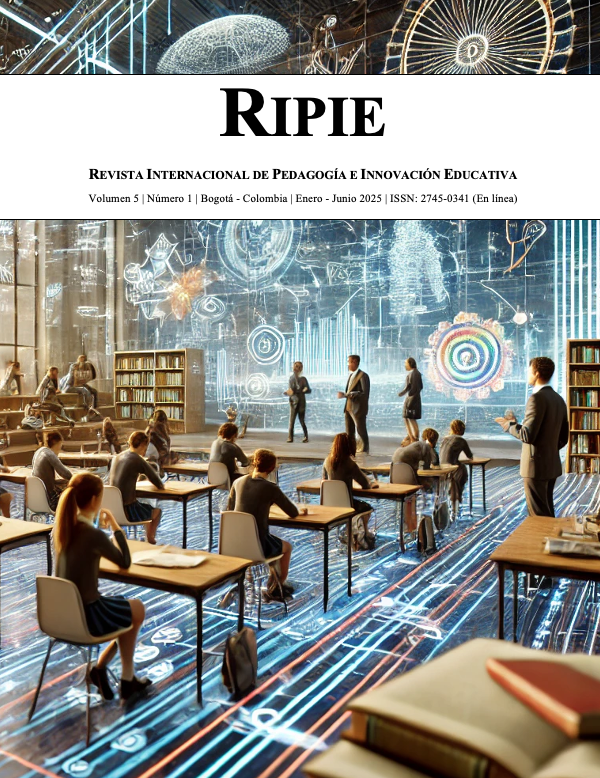Integración del pensamiento crítico y la toma de decisiones en la formación empresarial
Experiencias en la Universidad de Manresa
DOI:
https://doi.org/10.51660/ripie51237Palabras clave:
pensamiento crítico, simulación, debate, formación profesional, aprendizaje activo, administración y finanzas, comercio internacionalResumen
Este artículo analiza la integración del pensamiento crítico y la toma de decisiones en los estudios de empresa de la Universidad de Manresa, centrándose en las experiencias de Ciclos Formativos de Grado Superior de Empresa. A partir de una revisión bibliográfica exhaustiva, se explora cómo la utilización de debates académicos, basados en nueve modelos teóricos, y la implementación de simulaciones prácticas pueden potenciar las competencias cognitivas y la capacidad de decisión de los estudiantes. Los debates se plantean como una herramienta fundamental para fomentar el análisis crítico a partir de lecturas dirigidas, mientras que las simulaciones permiten contextualizar las decisiones empresariales en entornos cambiantes y complejos. A través de casos prácticos aplicados durante las sesiones académicas, se miden los efectos de estas metodologías en el desarrollo de competencias específicas como la resolución de problemas, la creatividad y la toma de decisiones éticas. Los resultados obtenidos demuestran que la combinación de ambas estrategias pedagógicas favorece un aprendizaje más profundo y significativo, preparando a los alumnos para entornos profesionales altamente dinámicos e inciertos.
Descargas
Referencias
Anderson, Phil & Lawton, Leigh. (2008). Business Simulations and Cognitive Learning: Developments, Desires, and Future Directions. Simulation & Gaming - Simulat Gaming. 40. 193-216. https://doi.org/10.1177/1046878108321624
Becker, Katrin. (2005). Learning by Doing, A Comprehensive Guide to Simulations, Computer Games, and Pedagogy in e-Learning and other Educational Experiences, 2005. by Clark Aldrich. The Canadian Journal of Learning and Technology. 31. 105-108.
Brookfield, S. D. (1987). Developing critical thinkers: Challenging adults to explore alternative ways of thinking and acting. Jossey-Bass.
Faisal, Nadia, Chadhar, Mehmood, Goriss-Hunter, Anitra, Stranieri, Andrew. (2022), Business Simulation Games in Higher Education: A Systematic Review of Empirical Research, Human Behavior and Emerging Technologies. https://doi.org/10.1155/2022/1578791
Feinstein, Andrew & Cannon, Hugh. (2002). Constructs of Simulation Evaluation. Simulation and Gaming. 33. 425,440. https://doi.org/10.1177/1046878102238606
Fisher, A. (2011). Critical Thinking: An Introduction. Cambridge University Press.
Freeman, S., Eddy, S. L., McDonough, M., Smith, M. K., Okoroafor, N., Jordt, H., & Wenderoth, M. P. (2014). Active learning increases student performance in science, engineering, and mathematics. Proceedings of the National Academy of Sciences of the United States of America, 111(23), 8410–8415. https://doi.org/10.1073/pnas.1319030111
Garo, Elona. (2017). Gap Between Theory and Practice in Management Education: Teaching Entrepreneurship Through Practice. https://doi.org/10.4018/978-1-5225-0770-3.ch014
Gredler, M. E. (2004). Games and Simulations and Their Relationships to Learning. In D. H. Jonassen (Ed.), Handbook of research on educational communications and technology (2nd ed., pp. 571–581). Lawrence Erlbaum Associates Publishers.
Hodgson, A., & Spours, K. (2003). Beyond A-levels: Curriculum 2000 and the Reform of 14-19 Qualifications (1st ed.). Routledge. https://doi.org/10.4324/9780203416631
Jonassen, D. H., & Grabowski, B. L. (1993). Handbook of Individual Differences, Learning, and Instruction. Routledge.
Kahneman, D. (2017). Thinking, Fast and Slow. Farrar, Straus and Giroux. https://doi.org/10.1017/CBO9781139012390
Kuhn, D., & Dean, D. (2004). Metacognition: A bridge between cognitive psychology and educational practice. Theory into Practice, 43, 268-273. https://doi.org/10.1207/s15430421tip4304_4
Kuhn, D. (1986). Education for Thinking. Teachers College Record, 87(4), 495-512. https://doi.org/10.1177/016146818608700404
Lean, J., Moizer, J., Towler, M., & Abbey, C. (2006). Simulations and games. Active Learning in Higher Education, 7(3), 227-242. https://doi.org/10.1177/1469787406069056
Lipman, M. (2012). Thinking in Education. Cambridge University Press.
https://doi.org/10.1017/CBO9780511840272
McMillan, J. H., & Schumacher, S. (2010). Research in Education: Evidence-Based Inquiry. Pearson.
Aclan, E. M., Noor Hashima, Abd Aziz and Valdez, N. (2016). Debate as a Pedagogical Tool to Develop Soft Skills in EFL/ESL Classroom: A Qualitative Case Study. Pertanika Journal of Social Science and Humanities. 24 (1): 213 – 240.
Paul, R., & Elder, L. (2003). The Miniature Guide to Critical Thinking Concepts and Tools. Foundation for Critical Thinking.
Prince, M. (2004), Does Active Learning Work? A Review of the Research. Journal of Engineering Education, 93: 223-231. https://doi.org/10.1002/j.2168-9830.2004.tb00809.x
Schumann, P.L., Anderson, P.H., Scott, T.W., & Lawton, L. (2001). A framework for evaluating simulations as educational tools. Developments in Business Simulation & Experiential Learning, 28, 215-220. Disponible en http://ABSEL.org
Scriven, M. & Paul, R. (2003). Defining critical thinking. Recuperado el 20 de marzo de 2017 desde Recuperado el 10 de septiembre de 2024 desde http://www.criticalthinking.org/pages/defining-critical-thinking/766
Shriner, Mary. (2006). Critical Thinking in Higher Education. InSight: A Journal of Scholarly Teaching. 1. 59-66. https://doi.org/10.46504/01200605sh
Sternod, L., & French, B. (2016). Test Review: Watson, G., & Glaser, E. M. (2010). Watson-GlaserTM II Critical Thinking Appraisal. Journal of Psychoeducational Assessment, 34(6), 607-611. https://doi.org/10.1177/0734282915622855
Thayer-Bacon, B. J. (2000). Transforming Critical Thinking: Thinking Constructively. Teachers College Press.
Zoller, U. (2018). Critical Thinking and Higher Order Thinking Skills in Higher Education: Bridging the Gap. Journal of Educational Research, 85(4), 301-315.
Descargas
Publicado
Número
Sección
Licencia
Derechos de autor 2025 Revista Internacional de Pedagogía e Innovación Educativa

Esta obra está bajo una licencia internacional Creative Commons Atribución-NoComercial-CompartirIgual 4.0.
Los artículos se publican bajo los términos de una licencia que permite el uso, distribución y reproducción en cualquier medio, siempre que el trabajo original se cite correctamente. Ed&TIC conserva los derechos patrimoniales de las obras publicadas y promueve activamente la reutilización de las mismas bajo los términos de la licencia mencionada anteriormente, lo que fomenta la difusión del conocimiento y la colaboración en la comunidad académica.


